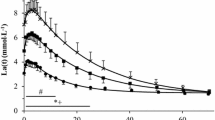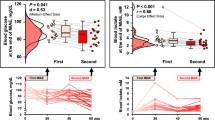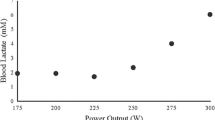Summary
The aim of this study was to elucidate the mechanism by which the disappearance of blood lactate following severe exercise is enhanced during active recovery in comparison with recovery at rest. Rates of decline of arterialised venous blood lactate concentrations in man after maximal one-leg exercise were compared during four different modes of recovery: passive (PR), exercise of the muscles involved in the initial exercise (SL), exercise of the corresponding muscles in the hitherto-inactive leg (OL), or exercise of one arm (RA). Recovery exercise workloads were each 40% of the onset of blood lactate accumulation (OBLA) for the limb used. In comparison with PR, SL and OL accelerated the fall in blood lactate to similar extents whereas RA was without effect. The first-order rate constant (min−1) for decline of arterialised venous blood lactate concentration after the intense exercise was 0.027 (0.003) in PR, 0.058 (0.025) in SL, 0.034 (0.002) in OL, and in RA was 0.028 (0.002) [mean (SEM),n = 6 subjects]. Preliminary studies had shown that RA in isolation elevated blood lactate whereas SL and OL did not. Thus, with appropriate workloads, exercise of either hitherto active or passive muscles enhanced blood lactate decline during recovery from intense exercise. This suggests that the effect resulted principally from the uptake and utilisation of lactate in the circulation by those exercising muscles rather than from increased transport of lactate to other sites of clearance by sustained high blood flow through the previously active muscles.
Similar content being viewed by others
References
Ahlborg G, Hagenfeldt L, Wahren J (1975) Substrate utilization by the inactive leg during one-leg or arm exercise. J Appl Physiol 39:718–723
Ahlborg G, Wahren J, Felig P (1986) Splanchnic and peripheral glucose and lactate metabolism during and after prolonged arm exercise. J Clin Invest 77:690–699
Belcastro AN, Bonen A (1975) Lactic acid removal rates during controlled and uncontrolled recovery exercise. J Appl Physiol 39:932–936
Bevegard BS, Shepard JT (1967) Regulation of the circulation during exercise in man. Physiol Rev 47:178–213
Brooks GA (1986) Lactate production during exercise: oxidizable substrate versus fatigue agent. In: Macleod D, Maughan RJ, Nimmo M, Reilly T, Williams C (eds) Exercise: benefits, limits and adaptations. Spon, London, pp 144–157
Clausen JP, Lassen NA (1971) Muscle blood flow during exercise in normal man studied by the133xenon clearance method. Cardiovasc Res 5:245–254
Dodd S, Powers SK, Callender T, Brooks E (1984) Blood lactate disappearance at various intensities of recovery exercise. J Appl Physiol 57:1462–1465
Eldridge FL (1975) Relationship between turnover rate and blood concentration of lactate in exercising dogs. J Appl Physiol 39:231–234
Felig P, Wahren J (1975) Fuel homeostasis in exercise. N Engl J Med 293:1078–1084
Forster HV, Dempsey JA, Thomson J, Vidruk E, doPico GA (1972) Estimation of arterial PO2, PCO2, pH and lactate from arterialized venous blood. J Appl Physiol 32:134–137
Freyschuss U, Strandell T (1967) Limb circulation during arm and leg exercise in supine position. J Appl Physiol 23:163–170
Gertz EW, Wisneski JA, Neese R, Bristow JD, Searle GL, Hanlon JT (1981) Myocardial lactate metabolism: evidence of lactate release during net chemical extraction in man. Circulation 63:1273–1279
Gisolfi C, Robinson S, Turrell ES (1966) Effect of aerobic work performed during recovery from exhausting work. J Appl Physiol 21:1767–1772
Heck H, Mader A, Hess G, Musce S, Muller R, Hollmann W (1985) Justification of the 4 mmol/l lactate threshold. Int J Sports Med 6:117–130
Hohimer AR, Hales JR, Rowell LB, Smith OA (1983) Regional distribution of blood flow during mild dynamic leg exercise in the baboon. J Appl Physiol 55:1173–1177
Issekutz B, Shaw WAS, Issekutz AC (1976) Lactate metabolism in resting and exercising dogs. J Appl Physiol 40:312–319
Johnson JM, Rowell LB (1975) Forearm skin and muscle vascular responses to prolonged leg exercise in man. J Appl Physiol 39:920–924
Jorfeldt L (1970) Metabolism of L(+)-lactate in human skeletal muscle during exercise. Acta Physiol Scand [Suppl 338]:5–67
McLellan TM, Skinner JS (1982) Blood lactate removal during active recovery related to the anaerobic threshold. Int J Sports Med 3:224–229
Noll F (1974) L-(+)-lactate determination with LDH, GPT and NAD. In: Bergmeyer HU (ed) Methods of enzymatic analysis. Academic Press, New York, 2nd edn, 3:1475–1479
Poortmans JR, Delescaille-Vanden Bossche J, Leclercq R (1978) Lactate uptake by inactive forearm during progressive leg exercise. J Appl Physiol 45:835–839
Rowell LB (1974) Human cardiovascular adjustments to exercise and thermal stress. Physiol Rev 54:75–159
Rowell LB (1986) Human circulation regulation during physical stress. Oxford University Press, New York
Shepherd JT (1967) Behaviour of resistance and capacity vessels in human limbs during exercise. Circ Res 20 [Suppl I]:70–82
Snedecor GW, Cochran WG (1967) Statistical methods. Iowa State University Press, Ames
Sokal RR, Rohlf FJ (1969) Biometry. Freeman, San Francisco
Stainsby WN, Welch HG (1966) Lactate metabolism of contracting dog skeletal muscle in situ. Am J Physiol 211:177–183
Stamford BA, Moffatt RJ, Weltman A, Maldonado C, Curtis M (1978) Blood lactate disappearance after supramaximal one-legged exercise. J Appl Physiol 45:244–248
Stamford BA, Weltman A, Moffatt R, Sady S (1981) Exercise recovery above and below anaerobic threshold following maximal work. J Appl Physiol 51:840–844
Stanley WC, Gertz EW, Wisneski JA, Neese RA, Morris DL, Brooks GA (1986) Lactate extraction during net lactate release in legs of humans during exercise. J AppI Physiol 60:1116–1120
Wahren J, Hagenfeldt L, Felig P (1975) Splanchnic and leg exchange of glucose, amino acids and free fatty acids during exercise in diabetes mellitus. J Clin Invest 55:1303–1314
Weltman A, Stamford BA, Fulco C (1979) Recovery from maximal effort exercise: lactate disappearance and subsequent performance. J Appl Physiol 47:677–682
Author information
Authors and Affiliations
Rights and permissions
About this article
Cite this article
McLoughlin, P., McCaffrey, N. & Moynihan, J.B. Gentle exercise with a previously inactive muscle group hastens the decline of blood lactate concentration after strenuous exercise. Europ. J. Appl. Physiol. 62, 274–278 (1991). https://doi.org/10.1007/BF00571552
Accepted:
Issue Date:
DOI: https://doi.org/10.1007/BF00571552




